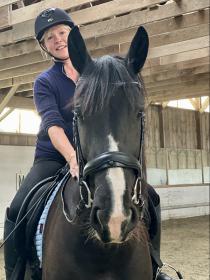Sorry so lon. The last day we did hand grazing she acted very spooky (late Sept). I realized at the end of our walk that every time I said we were done (I say "I-2-3, up, and she knows it’s time to move on and she had been very good about it), she would act spooky, I would let her graze a bit to calm down, then rinse and repeat. It finally dawned on me after the 5th or 6th time what had happened. Ugh. We had been hand grazing daily all spring and summer and this was the first time she’d done this.
We stopped hand grazing after that because she and all the other horses started acting crazy with a turn in weather (New Hampshire). I also think she started to get ulcers which we are in process of healing now.
So, fast forward to this past Sunday (early December). We had a photographer out to take photos and I thought her paddock would be a good place. It was early and she hadn’t finished her morning hay. Part way through our photoshoot, she started the “act spooky game”. After a few attempts and my realizing that we were not going to get any good photos, we finished our session. It was a very windy day and the horses had been in the day before due to weather so she was super distracted as well. However, I know the difference between her real spook and her “act spooky game”. Again, I accidentally allowed her to win and go back to her hay.
Since Sunday, she’s been fussy and a real bugger, guessing she’s vying for that leadership role she likes to challenge me on every now and again… The horses are in again today (extreme cold) so I went in to hand walk her in the indoor arena. We got around the arena a few times and then the “act spooky game” started again. We finished our lap then I took her back to her stall because I just am not sure how to fix this and it makes me really nervous. No one else was with us and I’m a believer of better safe than sorry.
Making her “work” (ie., circles) is only going to get her riled up more. We tried that for something else she was doing last spring. Would making her back up help? That’s another form of work and she will back up for me whenever I ask. I hate to make backing up a “bad” thing though but it may be my best choice, I’m not sure. It did help for the earlier issue (nipping). We do ground work and just did some on Monday after Sunday’s botched photoshoot. She was very good. That included some lunging, shoulders in, leg yields, backing up, walking at the pace I’m walking, stopping, turning, etc. She thought about acting out once but I got her attention and she made the right choice.
She will go through these little “teenager” stages then settles back to her mellow, silly self so I know this can be fixed and it’s not forever but I’m pretty sure I’m in a spot of trouble with this behavior. It makes me really nervous and she seems to be getting rather good at it. She doesn’t do it under saddle, thankfully! Just on the ground.
FYI - I board with about 70 horses and we do not have a round pen so please don’t suggest using one. [IMG]https://static.xx.fbcdn.net/images/emoji.php/v9/tf6/2/16/1f609.png) It’s also winter so no at liberty work in her paddock. Too icy!
[ATTACH=JSON]{“data-align”:“none”,“data-size”:“full”,“title”:“IMG_6303 sm.jpg”,“data-attachmentid”:10538669}[/ATTACH]


